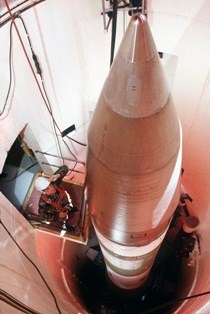Last updated: October 20, 2020
Article
The Minuteman III Missile

USAF
The Minuteman III was the first U.S. Intercontinental Ballistic Missile (ICBM) that could deliver Multiple Independent Reentry Vehicles (MIRVs) to a target. The missile can hold up to three warheads which can strike different targets miles away from each other.
Development Of A Flexible Response
Minuteman III represented a change in the United States' strategic planning, and consequently resulted in additional advancements in missile technology. Minuteman I was designed based on the theory of "massive retaliation" which required the missiles to launch at one time in retaliation to an attack. Minuteman II was designed based on the theory of "controlled response" which required some of the missile fleet to survive a nuclear attack. Minuteman III was designed under a theory of "flexible response" which required the missile to be able to fire independently and target multiple potential aggressors. Like the earlier Minuteman missiles, Minuteman III underwent rapid development.
Because of its ability to hold multiple warheads and an improved guidance system, there was a corresponding decrease in the power of its nuclear warheads. Less destructive force was now needed to destroy targets. Over the years, the Minuteman III has held warheads with 170, 340 and 450 kilotons of explosive power.
Past, Present & Future Deployment
There were once 700 Minuteman III's deployed out of Malmstrom Air Force Base in Montana (200), Minot Air Force Base in North Dakota (150), Grand Forks Air Force Base in North Dakota (150), and F.E. Warren Air Force Base in Wyoming (200). Today there are still over 400 Minuteman III missiles on alert at Malmstrom, Minot, and F.E. Warren Air Force Bases.
